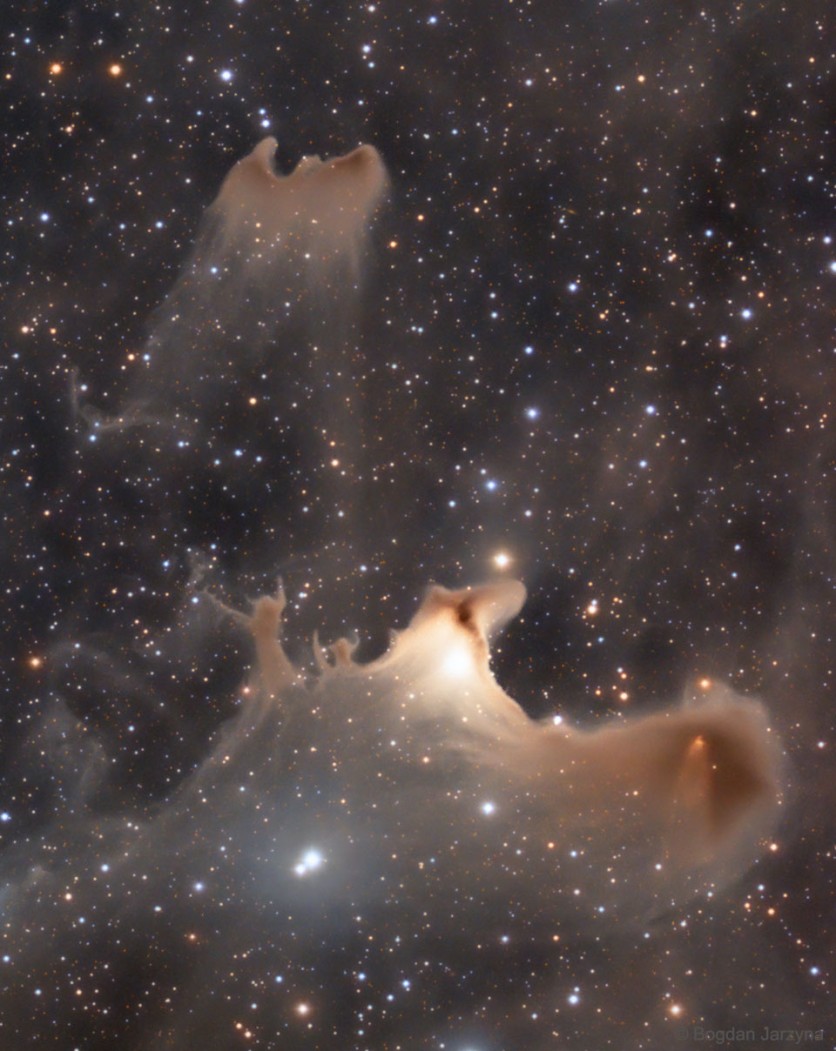NASA's Picture of the Day showcases an otherworldly scene within the Ghost Nebula, evoking an eerie ambiance fitting for the Halloween season.

Ghostly Shapes in the Ghost Nebula
In this celestial vista captured by astrophotographer Bogdan Jarzyna, a tapestry of stars and wispy clouds plays host to enigmatic shapes that appear to materialize from the interstellar expanse.
This jeweled cosmic panorama is adorned with clouds that shimmer with the reflected light of distant stars. It resides within the domain of the constellation Cepheus, a realm far removed from the familiar sights of Earth.
This ethereal display of cosmic artistry unfolds at the fringes of the Cepheus Flare molecular cloud complex, a colossal structure situated approximately 1,200 light-years distant from our home planet.
The Ghost Nebula, also known by its scientific designations VdB 141 and Sh2-136, commands attention with its expansive span, measuring over two light-years in diameter. Among the various spectral phantasms, the Ghost Nebula distinguishes itself by its pronounced luminosity.
The nebula is primarily composed of hydrogen gas, which is ionized by the intense ultraviolet radiation emitted by nearby hot stars. This process causes the gas to emit light, creating the characteristic glow that we observe. The Ghost Nebula is often characterized by its wispy, filamentary structures, giving it a ghostly and ethereal appearance, hence its name.
While it's an intriguing celestial object, the Ghost Nebula can be challenging to observe due to its faintness. It's best viewed using telescopes equipped with specialized filters that enhance the visibility of specific wavelengths of light emitted by the nebula.
The Cepheus Flare, which includes the Ghost Nebula, is a region of active star formation. Within these clouds of gas and dust, new stars are in the process of forming.
Over millions of years, the gravitational collapse of dense molecular clouds leads to the birth of young stars, which then go on to influence their surrounding environment through their radiation and stellar winds.
Spooky Season in Jupiter?
In another cosmic twist of spookiness, NASA's Juno spacecraft stumbled upon a scene straight out of a celestial ghost story during its 54th close flyby of Jupiter.
This snapshot, taken in a region of the giant planet's northern expanse known as Jet N7, reveals a dramatic display of clouds and storms along Jupiter's terminator - the line that marks the boundary between its illuminated and shadowed sides.
Bathed in an eerie "moonlight" from a low angle, this image provides a fascinating peek into the complex dance of Jupiter's atmosphere.
The cloud patterns on Jupiter in this photograph create a peculiar effect known as pareidolia, where astronomers spot shapes or figures in seemingly random arrangements.
In this instance, a curious face-like apparition seems to materialize from the clouds, infusing a playful touch of spooky charm into this cosmic panorama!
This captivating image was crafted by citizen scientist Vladimir Tarasov, harnessing the raw data from JunoCam. At the time of capture, Juno soared at an altitude of approximately 4,800 miles (about 7,700 kilometers) above Jupiter's cloud cover, stationed at a latitude of roughly 69 degrees north.

ⓒ 2026 TECHTIMES.com All rights reserved. Do not reproduce without permission.




